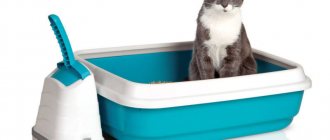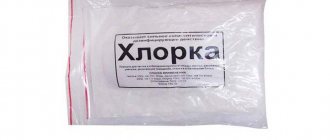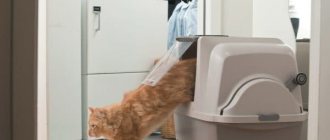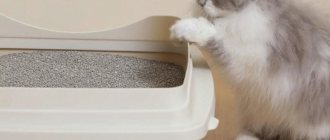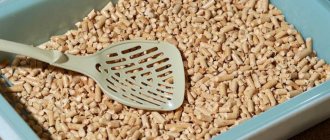Features of a tray with a grid
To make the task easier for owners, a special toilet was invented for cats and cats, in which the pet feels free. But why is it so unusual, this tray for a pet?
Most owners choose closed toilets, where pets feel private. On the one hand, this is suitable for shy cats who hide from prying eyes. On the other hand, the litter inside does not spill out and the room where the cat litter is located remains clean. But there is also a drawback: not all cats like to sit in a closed toilet. And that’s why some kitties categorically refuse to visit such a “outhouse”.
What is typical for a tray with a grid?
- First of all, it is a lightweight and convenient plastic design that fits in any part of the apartment and can be carried without any problems if necessary.
- A tray with a grid differs in that the filler is located at the very bottom, in an area inaccessible to cat paws. And thus allows you to maintain cleanliness while having an animal in the house. It is logical that if you cannot reach it, the cat will not scatter it, because there is nothing to scatter.
- A convenient grille, which is installed on top, allows the pet to do its cat “business” without hindrance. After this, he will be able to safely leave the toilet until the next time.
How to use a cat litter box correctly
Cats choose intimate places for the toilet, but who likes the smell and “heap” in an unexpected and hard-to-reach place. In order for the cat to get used to the designated “location” for the toilet and begin to use the tray for its intended purpose, you will have to teach your pet:
- place the toilet where the cat regularly goes;
- Move the tray a short distance day by day until you reach the desired location.
It is better if the cat litter box is secluded from prying eyes (for example, in the corner behind the washing machine) and is not located in the walkway.
The new tray is washed with laundry soap, rinsed several times in warm water, and allowed to dry. The same goes for the grate. Pour filler and a little freshener (optional) into the bottom. A mesh is placed on top.
Recommendations on how to use a cat litter box with a grid:
- Remove “lumps” in a timely manner by adding granules.
- If wood filler is used, the product is changed completely.
- Clean the grill regularly.
- Mandatory disinfection with detergent once every two weeks.
Advantages and disadvantages
Let's start with the pleasant things.
- It becomes clear that the obvious advantage is maintaining cleanliness. The cat relieves itself directly on the grate and does not touch the inside of the tray with the grate.
- Of course, the cat will not get the filler with its teeth and will not be able to taste it.
- It is worth noting that the advantage of this design is that the cat easily gets used to it and no longer does his “business” in another place.
- Manufacturers made sure that your apartment remains not only clean, but also aesthetically attractive, so they produced trays of various colors. You can choose the one that will be most in harmony with the overall decor in the room and will not be conspicuous by its inappropriate appearance and color.
One of the disadvantages is, perhaps, the fact that you will have to wash the grill every time after the cat poops. Feces left on the grate for a long time can cause an unpleasant odor and, of course, your pet is unlikely to want to go to that toilet again. Meanwhile, even this drawback is covered by the obvious “spoon of honey”: the grille is very easy to clean. It is enough to throw away the feces after the animal poops, and then place the grate under running water. This way it cleans perfectly and there are no problems with cleaning the cat litter.
A cat litter box with a mesh has similar properties. In this case, we can safely say that it is available to any owner, since it is inexpensive. In addition, the kitten will easily get used to it. The mesh will be safe for the baby, providing him with comfort.
As in the case of the grate, it is advisable to wash this structure after each visit by the cat to the toilet, so that the room always remains clean and fresh.
How to choose a filler?
Of course, if we highlight the top three, it will include: wood, clumping and silica gel fillers. They cope with their tasks perfectly and do not cause any trouble. The owner must decide for himself which one is best to choose, based on his experience and pet’s preferences.
Each time the pack runs out, take another litter to see how your cat reacts. Perhaps he will like the new one better than the previous one. Do not take bags in huge quantities, take small packs. So, you will come to the proper choice.
If the cat is not very capricious, make a choice in favor of the top three.
Terms of use
In order for your pet to use such a tray, you need to prepare it. Since it consists of two main parts, everything is done very simply.
- Place filler at the bottom of a dry and clean plastic container.
- A mesh or lattice is placed on the top of the cat litter box. It is advisable to leave space between the tray and the grid so that cat urine gets inside, onto the litter. If the pet poops, the feces remain on the grill, which is then removed and thoroughly washed under the tap and dried.
- It is necessary to periodically wash the cat litter so that nothing stagnates, and then put in new litter.
Why is there a mesh in the cat tray?
Among the wide range you can choose rectangular, oval and corner models. With a door, a carrying handle, even a carbon filter. It is advisable that the chosen “nook” for the cat be equipped with a special mesh.
The main purpose of the grill is to protect the animal from dirt. Liquid excrement seeps through the mesh. Hard ones will remain on top: just pull out the removable part and rinse under running hot water.
Many owners choose containers without a mesh, justifying the purchase based on the cat’s physiology:
- It’s inconvenient to drive your claws across plastic;
- feces remain on the mesh - which means the cat will still get its paws dirty, trying to bury the waste.
Then they are forced to buy a removable side that prevents the animal from scattering sand or granules, and a small rug on which the pet wipes its paws. Another reason to choose a litter box with mesh is that the mesh will prevent your cat from eating the kibble.
How to train a pet?
Preparing the toilet is only half the battle, since the other half comes from teaching your cat to go there to do its “business”. This works best when you have a small kitten.
- So, first of all, select a secluded place for the tray where the animal will feel comfortable.
- After this, you can put the cat in the tray several times a day. At the same time, make digging movements with its paws. Whenever you have the opportunity, watch the kitten and if you notice that the baby is acting restless, you can put it in the tray. If the kitten did his business there, be sure to reward him. Well, if the little cat did go the “wrong way,” you need to show the puddle to the baby and say something like: “Ugh” or “No way.” Gradually he will understand that he needs to go to the toilet in a certain place.
- If you have an adult cat, toilet training will be a little more difficult. Usually an animal that already has established habits has difficulty unlearning them. But even so, the situation is not hopeless. A cat is trained in much the same way, however, there are times when a pet, for some reason, purposefully relieves itself in another place. You can try to move the cat litter to where the cat does her business, and, quite possibly, the problem will be solved.
The main thing is not to frighten your pet and do not scold too much if the cat or kitten suddenly does something wrong. In the end, the pet will learn to use such a wonderful technique.
Varieties
Clumping: what are the features?
Bentonite clay and minerals are used to make these cat litter products. This hygiene product is widely known among cat owners and is often used. With its help, it is easy to absorb excess moisture, which turns into a lump. Using a spatula, the owner can easily remove used lumps of cat urine or feces from the toilet. It is recommended to buy clumping litter for a cat litter box if there is only one animal in the house, since if there are a large number of pets, the owner will have to remove the clumps throughout the day.
Veterinarians warn that this type of product is not suitable for a kitten who is constantly trying everything. If the filler gets into the animal's stomach, dangerous problems and complications may occur.
How is wood different?
Compressed sawdust granules retain odor well and are hypoallergenic, so they are suitable for both adults and small animals.
It is most profitable to fill a cat's litter box with this type of litter, since it is inexpensive and only a small amount of it needs to be placed on the bottom of the litter box. The product is compressed granules of sawdust, which become soaked upon contact with urine. A special feature of this litter intended for cat litter is its ability to retain odor well. Suitable not only for kittens, but the hygiene product is also used for adult cats. Since wood is a natural component, this filler almost never causes an allergic reaction in a cat.
Silica gel
Although this product is one of the most expensive, it does not require filling the cat's entire litter box. The filler consists of synthetic crystals of a transparent shade that absorb moisture well. The advantage of this product is the possibility of infrequent cleaning. If you fill the tray with a large layer of silica gel, then you will need to dispose of your cat’s litter box no more often than once every 2-3 weeks. The disadvantages of the litter are the sharp edges of the crystals and the loud rustling sound when the cat visits the litter box.
Features of mineral
The Fresh Step filler is a mineral filler, and when moisture gets in, it forms a lump, which makes it easy to clean the tray.
The composition includes clayey bentonite and palygorskite rocks. Popular brands of similar fillers:
- "Fresh step";
- "Murka";
- "Leopard";
- "Katsan";
- Jimpet Biocats;
- Vitacraft Compact Ultra.
After urination, a lump forms in the tray, which can be easily removed with a spatula. The main advantage of the hygiene product is that it is easy to clean, and it does not stick to the animal’s paws and does not spread around the house. It is possible to purchase filler with granules of different sizes. Experts do not recommend buying it for kittens who can swallow it. The disadvantage of mineral hygiene products is that they cannot be disposed of in the sewer.
How can you wash a cat's litter box without litter to prevent it from smelling? how to clean it from urinary stone?
How to wash a cat's litter box and how to remove urinary stones? A huge number of owners of domestic cats and especially cats are looking for the answer to this question every day. For those who do not yet have a furry pet, but the thought of the need to acquire a new friend has not left for a long time, such knowledge will also not be superfluous.
First of all, future owners study information about the rules of nutrition and keeping animals. But in the realities of life, people most often face not so much these difficulties as the problem of the smell emanating from the cat’s potty. This will especially complicate life for those who keep the animal exclusively at home, without letting it go outside at all. Daily washing of the tray for collecting feces eventually ceases to relieve the stench, and the “cat spirit” can already be felt far beyond the confines of the bathroom. This happens not because the tray was not washed, but because it was done incorrectly. Increased odor may also be caused by urinary stone growths.
For a comfortable neighborhood, you need to learn as much as possible about the proper care of cats and their litter boxes. The nuances of washing and the secrets of preventing odor will be revealed in this article. Choose the appropriate option for yourself and enjoy living together with a fluffy and mustachioed purring bundle!
Requirements
Before you start working, you need to know which design is preferable. It is important to decide on the size, since the tray should be comfortable for the animal. Otherwise, it will simply do its business where it is more convenient. The pet should be able to take a comfortable position, therefore:
- The best option is a flat, oblong-shaped device.
- If your cat is shy by nature and prefers to cope with large and small needs, an enclosed “house” would be a good solution.
- The depth of the future “toilet” should be no less than 50, but no more than 70-80 mm. If the tray is too shallow, then the filler, swelling, will spill out through the sides.
READ Why does a cat lose hair in clumps and have sores on the skin: causes, treatment, prevention
As for the material of manufacture, then:
- It is advisable that your DIY cat tray be made of plastic. This is a durable, affordable, and, most importantly, extremely easy-to-care material. It is extremely easy to wash and clean.
- In principle, metal is also a suitable option, but it quickly oxidizes, reacting with the animal’s urine.
- Wood is only suitable for temporary use, as it quickly swells, absorbs moisture, and a constant aroma reigns in the apartment, which is quite difficult to get rid of. For the same reason, a cardboard box for a cat’s “latrine” is not the best option.
Removing cat urine from shoes
As soon as traces of a pet's crime are noticed, it is necessary to place the shoes under cold water, treat the shoes with potassium permanganate and wash them (either in a washing machine or by hand). Then, of course, it is advisable to dry it outside, but if this is not possible, a loggia will do.
You can wash soiled shoes with laundry soap with a high glycerin content, which very easily breaks down cat urine crystals.
If a cat shits in shoes that cannot be washed (boots, shoes), then the first thing you need to do is get rid of the insoles, where most of the liquid has been absorbed. Wipe the remaining internal parts with a vinegar solution or potassium permanganate and leave to dry in the fresh air (street, balcony).
You can also use an alcohol solution of iodine to clean shoes, but this product can only be used on dark shoes; marks may remain on light shoes. It is very simple to prepare such a solution: add 10 drops of iodine to 1 liter of water.
https://youtube.com/watch?v=Nyh6nMfzHQw
https://youtube.com/watch?v=Nyh6nMfzHQw
Tray selection
Regular removal of excrement from the cat litter box, timely change of litter and periodic general cleaning will ensure the absence of unwanted odor in the house. But what if the owner does not have the opportunity to clean the toilet with the required frequency? In this case, you should take a closer look at special trays that do not allow the smell to spread.
Closed
Such a toilet not only keeps all the aromas inside, but also minimizes the scattering of the filler when buried. It is also perfect for those pets who do not like to relieve themselves in front of everyone. Manufacturers offer a wide selection of models with or without a door, corner and straight toilets.
Dry toilet
This is a fairly large product, equipped with a carbon filter and a fan. It eliminates unpleasant odors well, but requires regular filter changes.
You can learn about the intricacies of choosing a cat litter box from the video:
With automatic cleaning
These types of trays are high-tech devices that are capable of sifting, collecting and removing contaminated filler, using sewerage and water supply. The price of such toilets is quite high, but the owners do not have to waste time on cleaning and endure unpleasant odors.
Method for cleaning complex toilet stains
The fundamental way to clean the toilet from urinary stone and limescale is to use electrolyte (which is poured into batteries). When resorting to this method, you must work very carefully, be sure to wear rubber gloves, preferably goggles, and try not to inhale the fumes
Be careful when pouring liquid into the toilet to avoid splashing, which could get on your skin or clothing. This method can only be used if the pipes to the riser from the toilet are not plastic
Preventing the formation of plaque on the toilet
It happens that the cause of plaque is a malfunction of the toilet. In this case, you should try to eliminate the leak as quickly as possible. To avoid constantly flowing water, sometimes simply adjusting the float is enough. Sometimes you have to make more serious repairs, replacing some gaskets with new, more durable ones.
Special tablets for the toilet can help prevent the problem of limescale and urinary stones in a timely manner. Even if it has already appeared (in small quantities), the tablets will save you from plaque and help keep the toilet clean.
If you systematically, at least once a week, treat the toilet with cleaning agents, it will last much longer, and it will not be spoiled by an unpleasant red coating.
To prevent the re-formation of stones, you need to wash the toilet once a week with warm water and powder. Everything is simple here: the powder must be diluted in warm water and the surface of the toilet bowl must be cleaned from the inside with a regular abrasive sponge.
How to clear a clogged toilet
The blockage can be cleared using potato water. To do this, you need to pour boiling water into the drain and wait about 5 minutes. During this time, the sewer should clear. In addition, you can pour baking soda into the drain holes and turn on hot water after a few minutes. Baking soda will not only remove blockages in pipes, but also remove unpleasant odors from pipes.
To prevent the toilet and drain from becoming clogged, for preventive purposes, you can pour a bucket of hot water into it once a month. This is much easier and better than cleaning it with chemicals later.
Now you know several simple ways to clean a toilet quickly and effectively. I would like to believe that such troubles as limescale and urinary stone will no longer bother you, and your toilet will always be clean and sparkling.
What folk remedies will help wash
To clean your cat's litter box, you don't have to buy expensive store-bought chemicals. The funds available in every home will come to the rescue. The main thing is to know the rules for their use and cleaning methods.
Table vinegar
To clean with table vinegar, you need to heat the substance to forty °C and fill the tray so that all the plaque is in the liquid. In this state, the container should stand for a certain time. If the contamination is shallow, then one hour will be enough. In case of heavy contamination, you must wait at least three hours. As time passes, you need to drain the vinegar and clean the pot with a brush and abrasives. Clean until the surface of the tray becomes smooth. Then rinse it with warm water and wipe dry.
Baking soda
It is used for mechanical stone removal and disinfection. You need to start by washing the tray. Next, dry soda must be poured onto the rough surface and rubbed into the urinary stone with a brush until it is removed. After the procedure, the cat litter box is rinsed again with warm water and dried outside.
Laundry soap
Soap must be dissolved in hot water. A soap solution is poured into a large container and parts of the tray containing urinary stone are placed in it. Next, the tray soaks for 24 hours. After this, the stone is removed with a stiff brush, and the pot is rinsed with water and vinegar.
Mustard powder
Mustard powder is applied to the wet surface of the tray and rubbed with a stiff brush into the surface damaged by the urinary stone. After cleaning, rinse the container with water. This cleaning will not only get rid of the stone, but will also help get rid of animal marks on different surfaces.
How to disinfect cat litter?
If the tray is new and cleaned regularly, then it practically does not emit unpleasant odors. But over time, microscratches form in the plastic bottom, into which particles of urine, feces and dust become clogged. The question arises: how to wash the tray without smelling?
Modern means
Household and pet stores sell special products for cleaning cat litter boxes and eliminating unpleasant odors. Why is it better to use them for disinfection purposes?
- They do not cause allergies in pets and are safe in case of licking.
- Eliminate stubborn urinary stone stains on the bottom and walls.
- They have a neutral or pleasant smell for cats, which means that animals will not refuse to go to the tray after cleaning.
- Does not leave scratches.
- Eliminates odors of urine and feces.
The only drawback of modern products is the high price (500-800 rubles) compared to ordinary soap or baking soda.
Common Home Remedies
How to disinfect a cat's litter box if your budget is limited or you're just too lazy to go to the store? You can use regular detergents:
- laundry or baby soap (grate the shavings and dissolve in water);
- liquid soap;
- a mild detergent, such as delicates powder;
- dishwashing liquid;
- baking soda - 2 tablespoons per 200 ml of water.
It is important to choose a product without a strong odor, and at the end, thoroughly rinse the cat’s litter box in clean water, preferably several times. Cats especially do not like the scents of citruses and coniferous trees.
If the smell remains on the walls, the pet will pass by its toilet and relieve itself somewhere in a corner or on the carpet.
What absolutely cannot be used for disinfection?
- products containing chlorine - there is a high probability of poisoning when licked and inhaled;
- vinegar - most likely, due to the pungent smell, the cat will prefer another toilet place to the tray;
- powders like "Pemolux" - leave scratches on the plastic surface of the bottom.
Don't forget to clean the area around the tray. After relieving itself, the pet often digs into the litter: lumps fly to the floor, and dust rises into the air. Dirt near the toilet may be one of the reasons why a cat has a desire to shit in the apartment.


